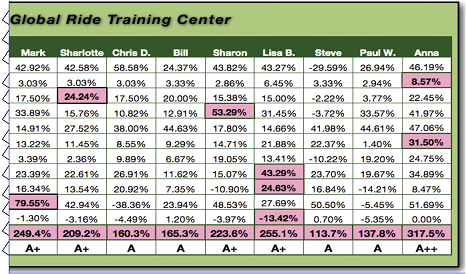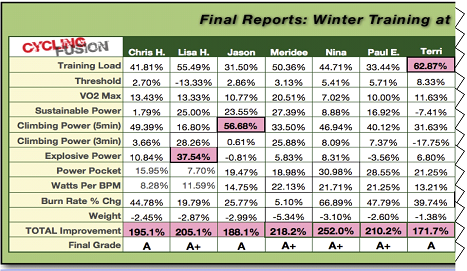Sixteen weeks, countless hours on the bike, more Yoga & Pilates than I thought I”™d ever see, and all the 40+ VO2 tests later, the results are finally in. The Winter Training program based on Cycling Fusion Training principles, at Global Ride has produced results that have exceeded even the most ambitious expectations set. These results were not relegated to just the first season participants either. From our newbies to our experienced racers, the numbers prove beyond a shadow of a doubt that This Stuff Really Works!
Rather than blather on, I”™ll simply describe how we arrived at these numbers, and define each of the metrics that we tracked throughout the sessions. Our methods were as scientific as is possible outside of a university setting. We required everyone to do a New Leaf metabolic test (measuring fat/carb burn rates, VO2, Threshold, Heart Zones, etc) one to two weeks before Winter Training began on January 2nd. We also used the first 2 weeks to measure everyone”™s baseline power numbers. Having the Keiser M3 to work with was the absolute key component of tracking and improving our progress for improving Power. From there, we kept track of these various metrics over the next 16 weeks of training, culminating with a post New Leaf test.

The percentages in the table images represent the amount of improvements each rider has achieved from the beginning of the year to about the middle of April - setting each one up for the cycling season of their lives. I graded anyone with cumulative improvements over 100% with an A, over 200% an A+, and one individual (our most improved rider) had a total of over 300% gain across multiple metrics. The highest degree of improvement in each category are highlighted by a pink cell, showing while they”™ve all had huge gains, each person responds differently to training, and thus they vary by which aspect of their riding and fitness improved the most.
Training Load: These are measured in Heart Zones® training load points. Each week riders were required to increase their load by 5%
Threshold: This is their measured heart rate where the body shifts its use of fat in the aerobic energy production system to carbs (actually, glycogen) in their “anaerobic” system. This is also their Lactate threshold, and team members were given lactate tests to double confirm these threshold values.
VO2 Max: The maximum amount of oxygen your body can take in to produce energy
Sustainable Power: The MSP (Maximum Sustainable Power) measured in Watts, for 20 minutes (all tests were done twice and averaged, with 5 min of rest between efforts)
Climbing Power (5 min): The MSP for the Climbing Power Zone. It represents power output for 5 minutes. Three efforts were averaged for each of these.
Climbing Power (3 min): Same as 5 min, only at higher power levels, for 3 minutes of power generation instead of 5.
Explosive Power: This is the MSP for the Explosive Power Zone - which is 1 minute power. Three efforts were averaged.
Pocket Power: During the New Leaf tests, we manually record their power numbers each minute of the test. The power each rider generates while they are within 15 beats of their threshold is their “Power Pocket”. This is similar to Sustainable Power in that it represents a hard effort that should be able to continue for very long rides.
Watts per BPM: This is an efficiency rating. Every Watt of power you produce is at some physiological cost. The heart rate is the easiest way to measure that price you are paying. Hence, the fewer heart beats that you require to produce the same Watts, or the more Watts you can produce with the same BPM (Beats Per Minute), the more efficient you are.
Burn Rate Change %: New Leaf measures how many calories you are burning in each heart zone. As you train your metabolism, the intention is to have your body learn to burn more fat, more often, and for longer periods of time. This preserves your glycogen for harder efforts, and makes you much more efficient at producing energy, especially over longer rides.
Weight: Not everyone attempted to lose weight, but even if that was not the goal, a lighter rider should be able to produce more Watts/Lb, thus becoming stronger and faster.

Originally posted 2010-05-23 06:09:43.
- Me & My Big Mouth - April 18, 2024
- Indoor Cycling Power Research #7: Good News, Bad News - August 16, 2023
- Blog Post #10 Baseline& Performance Testing - June 29, 2023

